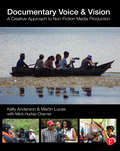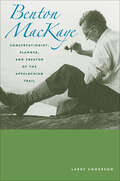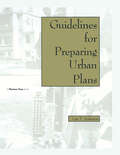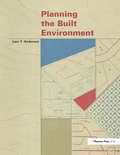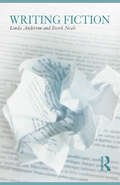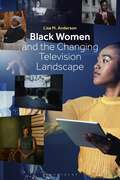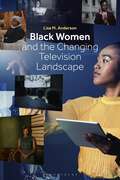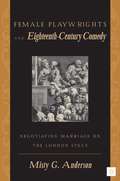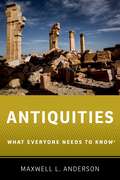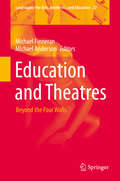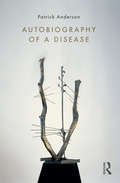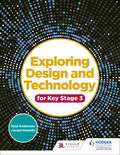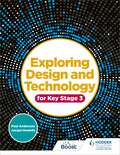- Table View
- List View
Documentary Voice & Vision: A Creative Approach to Non-Fiction Media Production
by Kelly Anderson Martin LucasLearn the creative and technical essentials of documentary filmmaking with Documentary Voice & Vision. This comprehensive work combines clear, up-to-date technical information, production techniques and gear descriptions with an understanding of how technical choices can create meaning and serve a director’s creative vision. Drawing on the authors’ years of experience as documentary filmmakers, and on interviews with a range of working professionals in the field, the book offers concrete and thoughtful guidance through all stages of production, from finding and researching ideas to production, editing and distribution. Documentary Voice & Vision will help students and aspiring filmmakers think though research and story structure, ethics, legal issues and aesthetics, as well as techniques from camera handling to lighting, sound recording and editing. The book explores a full range of production styles, from expository to impressionistic to observational, and provides an overview of contemporary distribution options. Documentary Voice & Vision is a companion text to Mick Hurbis-Cherrier’s Voice & Vision: A Creative Approach to Narrative Film and DV Production, and employs a similar style and approach to that classic text. This text is written from the perspective of documentary filmmakers, and includes myriad examples from the world of non-fiction filmmaking. A robust companion website featuring additional resources and interactive figures accompanies the book.
Design Energy Simulation for Architects: Guide to 3D Graphics
by Kjell AndersonLeading architectural firms are now using in-house design simulation to help make more sustainable design decisions. Taking advantage of these new tools requires understanding of what can be done with simulation, how to do it, and how to interpret the results. This software-agnostic book, which is intended for you to use as a professional architect, shows you how to reduce the energy use of all buildings using simulation for shading, daylighting, airflow, and energy modeling. Written by a practicing architect who specializes in design simulation, the book includes 30 case studies of net-zero buildings, as well as of projects with less lofty goals, to demonstrate how energy simulation has helped designers make early decisions. Within each case study, author Kjell Anderson mentions the software used, how the simulation was set up, and how the project team used the simulation to make design decisions. Chapters and case studies are written so that you learn general concepts without being tied to particular software. Each chapter builds on the theory from previous chapters, includes a summary of concept-level hand calculations (if applicable), and gives comprehensive explanations with graphic examples. Additional topics include simulation basics, comfort, climate analysis, a discussion on how simulation is integrated into some firms, and an overview of some popular design simulation software.
Design Energy Simulation for Architects: Guide to 3D Graphics
by Kjell AndersonLeading architectural firms are now using in-house design simulation to help make more sustainable design decisions. Taking advantage of these new tools requires understanding of what can be done with simulation, how to do it, and how to interpret the results. This software-agnostic book, which is intended for you to use as a professional architect, shows you how to reduce the energy use of all buildings using simulation for shading, daylighting, airflow, and energy modeling. Written by a practicing architect who specializes in design simulation, the book includes 30 case studies of net-zero buildings, as well as of projects with less lofty goals, to demonstrate how energy simulation has helped designers make early decisions. Within each case study, author Kjell Anderson mentions the software used, how the simulation was set up, and how the project team used the simulation to make design decisions. Chapters and case studies are written so that you learn general concepts without being tied to particular software. Each chapter builds on the theory from previous chapters, includes a summary of concept-level hand calculations (if applicable), and gives comprehensive explanations with graphic examples. Additional topics include simulation basics, comfort, climate analysis, a discussion on how simulation is integrated into some firms, and an overview of some popular design simulation software.
Benton MacKaye: Conservationist, Planner, and Creator of the Appalachian Trail (Creating the North American Landscape)
by Larry AndersonPlanner and originator of the Appalachian Trail and a cofounder of the Wilderness Society, Benton MacKaye (1879-1975) was a pioneer in linking the concepts of preservation and recreation. Spanning three-quarters of a century, his long and productive career had a major impact on emerging movements in conservation, environmentalism, and regional planning. MacKaye's seminal ideas on outdoor recreation, wilderness protection, land-use planning, community development, and transportation have inspired generations of activists, professionals, and adventurers seeking to strike a harmonious balance between human need and the natural environment.This pathbreaking biography provides the first complete portrait of this significant and unique figure in American environmental, intellectual, and cultural history. Drawing on extensive research, Larry Anderson traces MacKaye's extensive career, examines his many published works, and describes the importance of MacKaye's relationships with such influential figures as Lewis Mumford, Aldo Leopold, and Walter Lippmann. This book will appeal to students, scholars, and professionals in preservation, conservation, recreation, planning, and American studies, as well as general readers interested in these subjects.
Benton MacKaye: Conservationist, Planner, and Creator of the Appalachian Trail (Creating the North American Landscape)
by Larry AndersonPlanner and originator of the Appalachian Trail and a cofounder of the Wilderness Society, Benton MacKaye (1879-1975) was a pioneer in linking the concepts of preservation and recreation. Spanning three-quarters of a century, his long and productive career had a major impact on emerging movements in conservation, environmentalism, and regional planning. MacKaye's seminal ideas on outdoor recreation, wilderness protection, land-use planning, community development, and transportation have inspired generations of activists, professionals, and adventurers seeking to strike a harmonious balance between human need and the natural environment.This pathbreaking biography provides the first complete portrait of this significant and unique figure in American environmental, intellectual, and cultural history. Drawing on extensive research, Larry Anderson traces MacKaye's extensive career, examines his many published works, and describes the importance of MacKaye's relationships with such influential figures as Lewis Mumford, Aldo Leopold, and Walter Lippmann. This book will appeal to students, scholars, and professionals in preservation, conservation, recreation, planning, and American studies, as well as general readers interested in these subjects.
Guidelines for Preparing Urban Plans
by Larz AndersonWhile many authors have written about what urban plans should contain and how they should be used, this comprehensive book leads you step by step through the entire plan preparation process. Citing examples from across the country, Larz Anderson shows how to prepare, review, adopt, and implement urban plans. He explains how to identify public needs and desires, analyze existing problems and opportunities, and augment long-range general plans with short-range district and function plans. Anderson presents these guidelines as tasks. For each task, he explains the rationale behind it, recommends a procedure for completing it, and identifies the expected results. Throughout, Anderson encourages improvisation — he urges planners to adapt the guidelines to meet local needs. Excerpts from recently adopted general plans illustrate Anderson's points and provide examples of variations even within his recommendations. A related glossary gives comprehensive definitions to words that, though not technical, have meanings specific to the urban plan.
Guidelines for Preparing Urban Plans
by Larz AndersonWhile many authors have written about what urban plans should contain and how they should be used, this comprehensive book leads you step by step through the entire plan preparation process. Citing examples from across the country, Larz Anderson shows how to prepare, review, adopt, and implement urban plans. He explains how to identify public needs and desires, analyze existing problems and opportunities, and augment long-range general plans with short-range district and function plans. Anderson presents these guidelines as tasks. For each task, he explains the rationale behind it, recommends a procedure for completing it, and identifies the expected results. Throughout, Anderson encourages improvisation — he urges planners to adapt the guidelines to meet local needs. Excerpts from recently adopted general plans illustrate Anderson's points and provide examples of variations even within his recommendations. A related glossary gives comprehensive definitions to words that, though not technical, have meanings specific to the urban plan.
Planning the Built Environment
by Larz AndersonPlanning the Built Environment takes a systematic, technical approach to describing how urban infrastructures work. Accompanied by detailed diagrams, illustrations, tables, and reference lists, the book begins with landforms and progresses to essential utilities that manage drainage, wastewater, power, and water supply. A section on streets, highways, and transit systems is highly detailed and practical. Once firmly grounded in these "macro" systems, Planning the Built Environment examines the physical environments of cities and suburbs, including a discussion of critical elements such as street and subdivision planning, density, and siting of community facilities. Each chapter includes essential definitions, illustrations and diagrams, and an annotated list of references. This timely book explains new physical planning methods and current thinking on cluster development, new urbanism, and innovative transit planning and development. Planners, architects, engineers, and anyone who designs or manages the physical components of urban areas will find this book both an authoritative reference and an exhaustive, understandable technical manual of facts and best practices. Instructors in planning and allied fields will appreciate the practical exercises that conclude each chapter: valuable learning tools for students and professionals alike.
Planning the Built Environment
by Larz AndersonPlanning the Built Environment takes a systematic, technical approach to describing how urban infrastructures work. Accompanied by detailed diagrams, illustrations, tables, and reference lists, the book begins with landforms and progresses to essential utilities that manage drainage, wastewater, power, and water supply. A section on streets, highways, and transit systems is highly detailed and practical. Once firmly grounded in these "macro" systems, Planning the Built Environment examines the physical environments of cities and suburbs, including a discussion of critical elements such as street and subdivision planning, density, and siting of community facilities. Each chapter includes essential definitions, illustrations and diagrams, and an annotated list of references. This timely book explains new physical planning methods and current thinking on cluster development, new urbanism, and innovative transit planning and development. Planners, architects, engineers, and anyone who designs or manages the physical components of urban areas will find this book both an authoritative reference and an exhaustive, understandable technical manual of facts and best practices. Instructors in planning and allied fields will appreciate the practical exercises that conclude each chapter: valuable learning tools for students and professionals alike.
Writing Fiction
by Linda Anderson Derek NealeWriting Fiction offers the novice writer engaging and creative activities, making use of insightful, relevant readings from well-known authors to illustrate the techniques presented. This volume makes use of new versions of key chapters from the recent Routledge/Open University textbook Creative Writing: A Workbook with Readings for writers who are specializing in fiction. Using their experience and expertise as teachers as well as authors, Linda Anderson and Derek Neale guide aspiring writers through such key aspects of writing as: how to stimulate creativity keeping a writer’s notebook character creation setting point of view structure showing and telling. The volume is further updated to include never-before published interviews with successful fiction writers Andrew Cowan, Stevie Davies, Maggie Gee, Andrew Greig, and Hanif Kureishi. Concise and practical, Writing Fiction offers an inspirational guide to the methods and techniques of authorship and is a must-read for aspiring writers.
Writing Fiction
by Linda Anderson Derek NealeWriting Fiction offers the novice writer engaging and creative activities, making use of insightful, relevant readings from well-known authors to illustrate the techniques presented. This volume makes use of new versions of key chapters from the recent Routledge/Open University textbook Creative Writing: A Workbook with Readings for writers who are specializing in fiction. Using their experience and expertise as teachers as well as authors, Linda Anderson and Derek Neale guide aspiring writers through such key aspects of writing as: how to stimulate creativity keeping a writer’s notebook character creation setting point of view structure showing and telling. The volume is further updated to include never-before published interviews with successful fiction writers Andrew Cowan, Stevie Davies, Maggie Gee, Andrew Greig, and Hanif Kureishi. Concise and practical, Writing Fiction offers an inspirational guide to the methods and techniques of authorship and is a must-read for aspiring writers.
Black Women and the Changing Television Landscape
by Lisa M. AndersonBlack women's work in television has been, since the beginning, a negotiation. Black Women and the Changing Television Landscape explores the steps black women, as actors, directors, and producers, have taken to improve representations of black people on the small screen. Beginning with The Beulah Show, Anderson articulates the interrelationship between US culture and the televisual, demonstrating the conditions under which black women particularly, and black people generally, exist in popular culture.
Black Women and the Changing Television Landscape
by Lisa M. AndersonBlack women's work in television has been, since the beginning, a negotiation. Black Women and the Changing Television Landscape explores the steps black women, as actors, directors, and producers, have taken to improve representations of black people on the small screen. Beginning with The Beulah Show, Anderson articulates the interrelationship between US culture and the televisual, demonstrating the conditions under which black women particularly, and black people generally, exist in popular culture.
Stitch It for Autumn: Seasonal sewing projects to craft and quilt (Stitch It Ser.)
by Lynette AndersonA gorgeous collection of Spring-themed quilting and stitching designs from top fabric designer Lynette Anderson, including table runners, wall hangings and larger quilts, as well as smaller, quick-to-stitch gifts, all featuring Lynette's new fabric range from Lecien. Beautiful fabrics, fresh colours and cute designs are enhanced by a book design that captures Lynette’s heart-warming, quirky style.
Female Playwrights and Eighteenth-Century Comedy: Negotiating Marriage on the London Stage
by M. AndersonAphra Behn, Susannah Centlivre, Hannah Cowley, and Elizabeth Inchbald were the only four female playwrights in England with multiple comic successes from 1670-1800. Behn's interest in the body, Centlivre's fascination with written contracts, Cowley's nationalism, and Inchbald's discussion of divorce emerge in the comic events that are animated by the psychological mechanisms of humor. Attending to the dialogue between these comic events and the plays' more predictable comic endings illuminates the philosophical, political, and legal arguments about women and marriage that fascinated both female playwrights and the theatergoing public.
Antiquities: What Everyone Needs to Know® (What Everyone Needs To Know®)
by Maxwell L. AndersonThe destruction of ancient monuments and artworks by the Taliban in Afghanistan and the Islamic State in Iraq and Syria has shocked observers worldwide. Yet iconoclastic erasures of the past date back at least to the mid-1300s BCE, during the Amarna Period of ancient Egypt's 18th dynasty. Far more damage to the past has been inflicted by natural disasters, looters, and public works. Art historian Maxwell Anderson's Antiquities: What Everyone Needs to Know® analyzes continuing threats to our heritage, and offers a balanced account of treaties and laws governing the circulation of objects; the history of collecting antiquities; how forgeries are made and detected; how authentic works are documented, stored, dispersed, and displayed; the politics of sending antiquities back to their countries of origin; and the outlook for an expanded legal market. Anderson provides a summary of challenges ahead, including the future of underwater archaeology, the use of drones, remote sensing, and how invisible markings on antiquities will allow them to be traced. Written in question-and-answer format, the book equips readers with a nuanced understanding of the legal, practical, and moral choices that face us all when confronting antiquities in a museum gallery, shop window, or for sale on the Internet.
ANTIQUITIES WENK C: What Everyone Needs to Know® (What Everyone Needs To Know®)
by Maxwell L. AndersonThe destruction of ancient monuments and artworks by the Taliban in Afghanistan and the Islamic State in Iraq and Syria has shocked observers worldwide. Yet iconoclastic erasures of the past date back at least to the mid-1300s BCE, during the Amarna Period of ancient Egypt's 18th dynasty. Far more damage to the past has been inflicted by natural disasters, looters, and public works. Art historian Maxwell Anderson's Antiquities: What Everyone Needs to Know® analyzes continuing threats to our heritage, and offers a balanced account of treaties and laws governing the circulation of objects; the history of collecting antiquities; how forgeries are made and detected; how authentic works are documented, stored, dispersed, and displayed; the politics of sending antiquities back to their countries of origin; and the outlook for an expanded legal market. Anderson provides a summary of challenges ahead, including the future of underwater archaeology, the use of drones, remote sensing, and how invisible markings on antiquities will allow them to be traced. Written in question-and-answer format, the book equips readers with a nuanced understanding of the legal, practical, and moral choices that face us all when confronting antiquities in a museum gallery, shop window, or for sale on the Internet.
How Drama Activates Learning: Contemporary Research and Practice
by Michael Anderson Julie DunnHow Drama Activates Learning: Contemporary Research and Practice draws together leaders in drama education and applied theatre from across the globe, including authors from Europe, North America and Australasia. It explores how learning can be activated when drama pedagogies and philosophies are applied across diverse contexts and for varied purposes. The areas explored include: · history · literacy, oracy and listening· health and human relationships education· science · democracy, social justice and global citizenship education· bullying and conflict management· criticality· digital technologies· additional language learningDrawing on a range of theoretical perspectives, the contributors present case studies of drama and applied theatre work in school and community settings, providing rich descriptions of practice accompanied by detailed analysis underpinned by the theoretical perspectives of key thinkers from both within and beyond the field of drama.
How Drama Activates Learning: Contemporary Research and Practice
by Michael Anderson Julie DunnHow Drama Activates Learning: Contemporary Research and Practice draws together leaders in drama education and applied theatre from across the globe, including authors from Europe, North America and Australasia. It explores how learning can be activated when drama pedagogies and philosophies are applied across diverse contexts and for varied purposes. The areas explored include: · history · literacy, oracy and listening· health and human relationships education· science · democracy, social justice and global citizenship education· bullying and conflict management· criticality· digital technologies· additional language learningDrawing on a range of theoretical perspectives, the contributors present case studies of drama and applied theatre work in school and community settings, providing rich descriptions of practice accompanied by detailed analysis underpinned by the theoretical perspectives of key thinkers from both within and beyond the field of drama.
Education and Theatres: Beyond the Four Walls (Landscapes: the Arts, Aesthetics, and Education #27)
by Michael Anderson Michael FinneranThis volume is the first book to map a broad range of practices and critically examine the impact of education and outreach programmes in theatres and theatre companies around the globe.This innovative volume looks specifically at the manner in which theatres and theatre companies engage in educational, outreach and community work. An array of global case studies examines a wide range of existing and innovative practices, and scrutinises how this work achieves successful results and delivers impact and outcome on investment.The editors set the scene briefly in terms of the history of education in theatre organisations, and then move on to chart some of the difficulties and challenges associated with this work, as well as looking into the conceptual issues that need to be interrogated so that we may understand the impact of outreach and education work on the communities and audiences it aims to reach. A range of theatre practitioners and academics describe their work, its background, and what the authors understand to be successful outcomes for both the participants and the theatres. Finally, the book offers suggestions for both practitioners and researchers regarding further development in this work.
Basics Architecture 03: Architectural Design (Basics Architecture)
by Ms Jane AndersonBasics Architecture 03: Architectural Design explains the process of designing architectural projects. It describes the design studio and the activities that take place there.The architectural design process is as diverse as the people who practise it; all architects follows their own individual design process. In this dynamic new text the realities of the design process and the relationship between education and practice are explored in detail.The book introduces a variety of processes through examples and case studies. This allows readers to identify with certain methods with which they could respond to in their own work, and enables them to develop their own unique approach.
Autobiography of a Disease (Writing Lives: Ethnographic Narratives)
by Patrick AndersonAutobiography of a Disease documents, in experimental form, the experience of extended life-threatening illness in contemporary US hospitals and clinics. The narrative is based primarily on the author’s sudden and catastrophic collapse into a coma and long hospitalization thirteen years ago; but it has also been crafted from twelve years of research on the history of microbiology, literary representations of illness and medical treatment, cultural analysis of MRSA in the popular press, and extended autoethnographic work on medicalization. An experiment in form, the book blends the genres of storytelling, historiography, ethnography, and memoir. Unlike most medical memoirs, told from the perspective of the human patient, Autobiography of a Disease is told from the perspective of a bacterial cluster. This orientation is intended to represent the distribution of perspectives on illness, disability, and pain across subjective centers—from patient to monitoring machine, from body to cell, from caregiver to cared-for—and thus makes sense of illness only in a social context.
Autobiography of a Disease (Writing Lives: Ethnographic Narratives)
by Patrick AndersonAutobiography of a Disease documents, in experimental form, the experience of extended life-threatening illness in contemporary US hospitals and clinics. The narrative is based primarily on the author’s sudden and catastrophic collapse into a coma and long hospitalization thirteen years ago; but it has also been crafted from twelve years of research on the history of microbiology, literary representations of illness and medical treatment, cultural analysis of MRSA in the popular press, and extended autoethnographic work on medicalization. An experiment in form, the book blends the genres of storytelling, historiography, ethnography, and memoir. Unlike most medical memoirs, told from the perspective of the human patient, Autobiography of a Disease is told from the perspective of a bacterial cluster. This orientation is intended to represent the distribution of perspectives on illness, disability, and pain across subjective centers—from patient to monitoring machine, from body to cell, from caregiver to cared-for—and thus makes sense of illness only in a social context.
Exploring Design and Technology for Key Stage 3
by Paul Anderson Jacqui HowellsDevelop knowledge, understanding and designing and making skills through Key Stage 3 so students are ready for the new GCSE in Design and Technology, with our brand-new Student Book.With topics directly linked to the new GCSE (9-1) specifications, Exploring Design and Technology will build a solid foundation by boosting your students' understanding of the key concepts, introducing them to important terminology and developing their practical skills through Key Stage 3.· Build understanding through years 7, 8 and 9 with engaging, carefully timed and level-appropriate lessons that draw on the GCSE subject content.· Develop practical skills with a variety of creative designing and making activities that use a wide range of materials, tools, equipment and processes. · Boost knowledge with clear explanations of important terminology and concepts that students will need to apply when identifying design problems, understanding user needs and developing design solutions in a range of contexts.· Encourage subject interest with 'find out more' - research features that broaden understanding of materials and their working properties, new technologies and the wider influences on designing and making.· Monitor and measure student progress with knowledge check questions provided for every topic.
Exploring Design and Technology for Key Stage 3
by Paul Anderson Jacqui HowellsDevelop knowledge, understanding and designing and making skills through Key Stage 3 so students are ready for the new GCSE in Design and Technology, with our brand-new Student Book.With topics directly linked to the new GCSE (9-1) specifications, Exploring Design and Technology will build a solid foundation by boosting your students' understanding of the key concepts, introducing them to important terminology and developing their practical skills through Key Stage 3.· Build understanding through years 7, 8 and 9 with engaging, carefully timed and level-appropriate lessons that draw on the GCSE subject content.· Develop practical skills with a variety of creative designing and making activities that use a wide range of materials, tools, equipment and processes. · Boost knowledge with clear explanations of important terminology and concepts that students will need to apply when identifying design problems, understanding user needs and developing design solutions in a range of contexts.· Encourage subject interest with 'find out more' - research features that broaden understanding of materials and their working properties, new technologies and the wider influences on designing and making.· Monitor and measure student progress with knowledge check questions provided for every topic.
